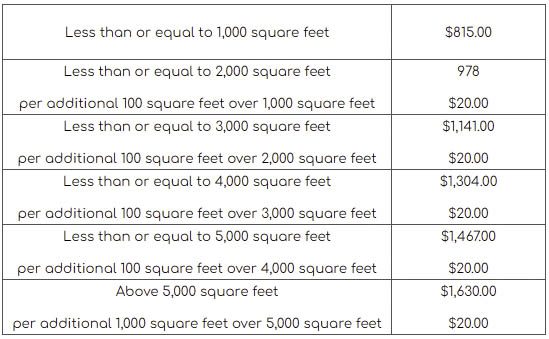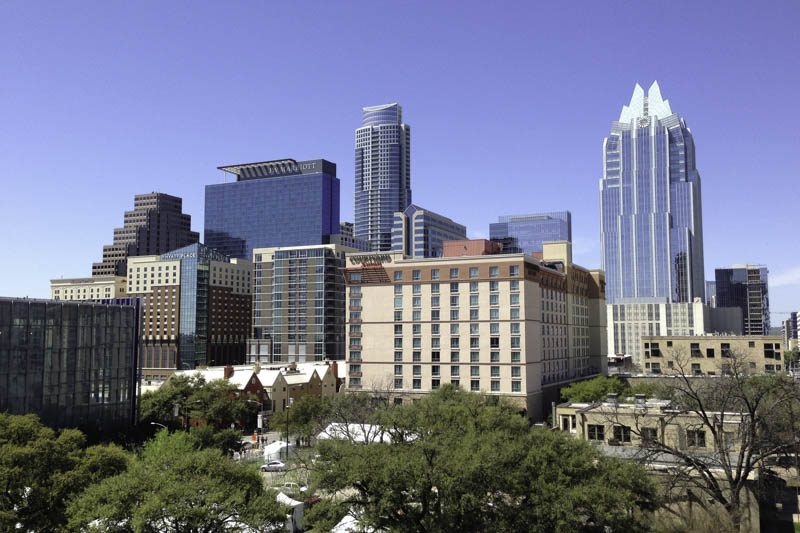The Cost of Building a Custom Home in Austin
Despite the skyscraper boom in recent years, the demand for single-family homes in Austin remains strong. During the pandemic, a lot of people have been moving to the area or have been upgrading to bigger homes, seeking more space as they now spend more time at home, working remotely. The average home size in Austin is now 2,092 square feet, more than 200 square feet above the national average of 1,838 square feet. New home construction is also experiencing a boom in the industry, although it is currently still unable to keep up with the demand given the current supply.

Figure 1. Typical cost breakdown of a single-family home constructed using the conventional method, according to Home Builder Digest.
Nationwide, the average cost to build a home falls between $100 to $155 per square foot. For Austin, it starts at about the same range of around $140 to $150 per square foot but can go all the way up to $300 per square foot.
This cost varies from location to location due to several factors that can be divided into two categories: hard costs and soft costs. Hard costs include the expenses that go into the physical structure such as the cost of materials and the construction itself. Soft costs cover the other expenses such as the cost of the land, permit fees, and architecture and design fees.
Hard Costs
Everything that goes towards the physical structure of the home falls under hard costs, from the cost of lumber to hurricane-proofing. Financial resource Howmuchly estimates the cost to build a home in Austin to start at about $150 per square foot going up to about $300 per square foot. Bid data from online contractor marketplace BuildZoom (BZ) further breaks down the cost, with the lower range starting around $140 to $150 per square foot, the mid-range at about $175 to $200 per square foot, and the high-end range at about $250 and beyond.
Throughout the pandemic, the rising price of lumber added approximately $24,000 to $36,000 to the price of a new home. Prices have started falling back down below $1,000 per thousand board feet around June, although there are still supply chain issues in other areas.
Being prone to devastation by hurricanes, homes within the state of Texas have to be built to sustain natural disasters. Howmuchly estimates the cost to hurricane-proof a house in Austin to be around $25,000 to $50,000, totaling higher the stronger a home you build. This cost is broken down as follows:
- Hurricane-proof Door $1,000
- Garage $2,000
- Saferoom $5,000
- Back-up Generator $6,000
- Gas or Woodstove $5,000
- Hurricane-proof Windows $40-$55 per square foot
Soft Costs
Other expenses beyond the physical structure of the house fall under soft costs. These include costs related to land, permit fees charged by the city, and architecture and labor fees.
Cost of the Land
Lot prices in the Austin-Waco-Hill Country region of Central Texas have risen 7.07% to $4,424 per acre. This follows a boom in sales in countryside areas over the pandemic, which seems to have prompted many to seek out a more relaxed living environment.
Austin has the third-highest average residential lot size among the 20 largest U.S. cities, at 8,629 square feet, which has attracted those seeking more space as they spend more time at home these days. Homes in the city typically take up only 21.6% of the average lot size, giving more room for yard space.
Listings for lots in the city on Redfin range from 5,009 to 12,632 square feet and average at $62 per square foot.
Permits and Other Fees
Each permit fee charged by the City of Austin Development Services Department (DSD) incurs a 4% Tech Surcharge. The DSD Fee Schedule reflects the plan review fees for residential building new construction as follows:

Building, electrical, mechanical, plumbing, and energy permit fees are as follows:

Figure 2. Cost breakdown of building, electrical, mechanical, plumbing, energy permit fees for single family, duplex, townhouse, and other residential structures. Image Source: City of Austin Development Services Department Fee Schedule.
Other permit and miscellaneous fees are detailed further in the same document.
Architecture and Design Fees
According to Austin-based architect Webber + Studio, the city has higher architectural costs than non-metropolitan areas. This costs between 9.55 to 10.03% of total construction costs for residential architectural services, quite close to other major Texas cities like Houston and San Antonio. This amounts to about $350 to $350 per square foot, going up to $600 to $800 per square foot for luxury projects.
Architecture fees typically cover five basic phases. The first is Schematic Design, where the architect draws up preliminary designs based on the client’s vision. Design Development will then build upon the client’s feedback on the initial design, which can be delivered through a 3D virtual model. Detailed designs will then be drawn up in the Construction Documentation phase to be cascaded to contractors for pricing and building and also submitted to the city for permitting. In the Bidding and Negotiation phase, the architect will help the client analyze the contractors’ pricing to gauge against their vision and budget. Finally, in Construction Administration, the architect oversees the actual building of the design through regular visits and coordination with the contractor.
How do the custom home building costs in Austin compare to other nearby cities?

Homebuilding costs, in general, are higher in metropolitan areas like Austin compared to non-metropolitan areas. Permits from the last five years gathered from online contractor marketplace BuildZoom (BZ) show that the cost to build a new home between 4,000 to 5,000 square feet in the suburb of Leander ranged from $341,100 to $489,000. Meanwhile, relatively smaller homes in San Marcos, ranging from 2,000 to 4,000 square feet, cost between $125,840 to $350,000 to build.
What Leading Custom Home Builders and Architects that Serve the Austin Area Say
Steve Zbranek, co-owner of Austin-based Zbranek & Holt Custom Homes, writes about all the challenges builders had to go through when COVID hit. “The first sign of trouble came from positive covid tests, creating new job site rules and city-mandated job site lockdowns. The solution for this was to regulate how many workers could be on a job at the same time.” He relates how worker shortage quickly spread in the industry, causing offices to close for days and remain short-staffed long after.
Then, the supply issues came in. “Lumber started to imitate Tesla stock and rose to prices never before seen.” This hurt not just the vendors and builders, but clients as well, especially those whose projects started in early 2020. “Using the ‘show must go on’ mentality, some of us took the hit, some split it with clients, and some passed it on depending upon their contractual status. What a mess!” Down the line, lead times for windows, appliances, and plumbing and light fixtures also contributed to builders missing their deadlines and blowing out their budgets. He adds that even today, it still remains difficult to document the cost to construct in this ever-changing market. “We are learning to build homes with new rules, in a market that continues to supply us with willing buyers.”

Matt Fajkus, American Institute of Architects (AIA) and Leadership in Energy and Environmental design (LEED) Accredited Professional, Principal Architect of Matt Fajkus Architecture, notes that the market in Austin has always been more expensive than others and has “exploded exponentially higher since the pandemic.” Working with dozens of other builders across the city on residential projects, he says the low-end of a spec house quality home would already range between $300 to $400 per square foot. For a reasonable-quality and architecturally-designed custom house, the cost would go up to $600 per square foot, while a high-end home could reach up to $1,200 per square foot.
“I have also spoken with many architects about this in committees and they’re seeing the same thing. We have designed numerous houses in each of these brackets, and most architects have multiple projects currently landing in the $600 – $1,000 per square feet for high-end custom residential,” he says, adding, “It seems that this will be the new base in the region, and even if the spikes might calm down, the costs are not likely to drop from this level in the future. It’s only a matter of whether they will gradually grow or more steeply grow in coming years.”
The Future of Austin’s Residential Construction Industry
In spite of the pandemic, Austin’s home construction industry has continued to be busy. But the Texas Real Estate Research Center at Texas A&M University expects it to slow down in 2022 along with other major cities in the state. The number of single-family home construction permits in Austin grew 19.4% from 2019 to 2020 and is expected to register a 20.8% growth in 2021. For 2022, however, the center predicts year-over-year growth will drop to 5.2%, and even lower in 2023 to 4.8%. It expects the housing market to stabilize to a more sustainable long-term path moving forward from pandemic-induced activity.
This activity was also fueled by low mortgage rates and strong population growth. The larger lots and home sizes in the city have drawn a lot of people from other cities in the midst of the widespread shift to working from home, a movement that in turn is likely to continue the trend of bigger homes in Austin. Consequently, home values are going up as well, with the median home price in the city now at nearly $575,000, compared to the national median of $350,000.
Nearby Development
A lot of other developments are also still going on around the area. In the nearby suburb of Georgetown, the 454-acre mixed-use Parmer Ranch project is underway. Once completed, the project will have a total of 1,000 single-family homes, a whole array of parks and amenities, and its own elementary school in the master-planned community.
Considering building a home in Austin?
Contact us for a free consultation

